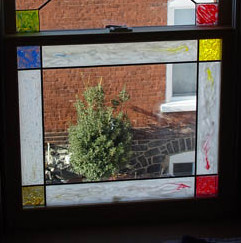I tend to customize things to make them my own: like the Mercedes-Benz hood ornament and trunk star on my Scion xB. The windows I am installing are plain and undivided. We like them, because they let in lots of light, but they are plain. I decided to give them a craftsman touch.
Craftsman style is enjoying a revival these days in an ironic form. Craftsman is the shorthand name for the American arts and crafts movement. This movement was a response to the dehumanization caused by the industrial revolution, with its concentration of wealth in the hands of those who controlled the means of production and an erosion of the middle class. The industrial revolution with its mass production meant that only the very rich could afford art and beauty; the middle class could afford cheap, mass produced ornamentation; the poor laborers were left with tenements. The British arts and crafts movement was part of a socialist response to these conditions. At its core, it was a democratization of art and an assertion of the value of manual labor and the human touch.
When the movement crossed the Atlantic to America, the philosophy remained the same, but the forms changed. True Craftsman decor is to be made of local materials, whenever possible, and made, or at least installed, by the homeowner himself. The artwork is incorporated into everyday functional things. A “trademark” of the work is that much of the time some part of the work is left intentionally and prominently unfinished. This was regarded as the signature if you will that the work was done by the lord of the manor who was free to finish it or not at his whim. It was not the product of a machine or a servant who had to satisfy someone else’s demands. Finally! I have a good, socialist explanation for all the unfinished projects around here! It’s not because I am in over my head, or because I am lazy or too busy. It’s because I am a free man!
Back to the topic. The current revival of the Craftsman style is ironic, because it is mass manufactured and professionally installed. Just about every house on TV shows these days is an oversized McMansion wrapped in vinyl clad Craftsman accessories.
Back to the windows. Since they need to be insulated glass, I don’t have the luxury to make them true stained glass with lead dividers. So I went to my local arts and crafts big box store and bought self adhesive lead strip on a ten meter roll and several bottles of liquid “glass stain”. They make solvent based and water based stain. so, if you value your health and your indoor air quality, read the fine print and get the water based.

I varnished the interior of the window sash frame, then applied the lead using a piece of cardboard cut to 2-1/2″ wide as a guide. I pressed it against the glass, while holding it tightly against the edge of the cardboard. I was simultaneously holding the cardboard flat against the glass making sure it was tight against the frame. Then I used the burnishing tool to press the lead firmly against the glass. This flattens and straightens it slightly and makes sure it adheres to the glass.
Then I washed my hands with cold water and soap, then hot water. It is lead. You don’t want any of it to stay on your skin. The lead was manufactured in France. Most of the back of the package was covered by a huge label in fine print warnings about lead. Below this there were about five lines of instructions for its use in French. This is where my two years of college French came in handy. Sometimes you need to be able to read a foreign language to do something.
Then I squeezed the faux stain onto the glass a section at a time, carefully smoothing it out as I went. I mixed colors on the glass and experimented with textures, blends and patterns. The first set of sashes I did was for the upstairs bathroom. I could be more playful with them, since I had already decorated the bathroom with a yellow and blue rubber ducky theme. The stain is opaque like Elmer’s Glue when it is wet. It takes between 8 and 72 hours to dry to be more transparent. That is, unless it is supposed to be more opaque when it is dry.
I decided to try a different pattern for the upper sash, utilizing the double strip feature of the lead I was using.
 The upper right square was a failed attempt to blend red and blue to make purple. It reminds me of Spiderman. The upper left is clear stain with champagne swirled in a spiral. The lower left of the upper sash is very nice swirls of blue and yellow making green.
The upper right square was a failed attempt to blend red and blue to make purple. It reminds me of Spiderman. The upper left is clear stain with champagne swirled in a spiral. The lower left of the upper sash is very nice swirls of blue and yellow making green.
Anyway, you get the idea.
Most of the windows, we are just adding the lead on the bottom sashes with random colors and textures in the corners.The top sashes will just get lead with the circle pattern, but no color.























